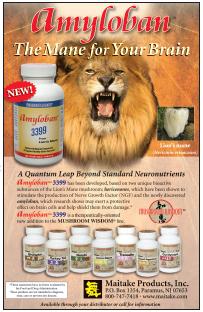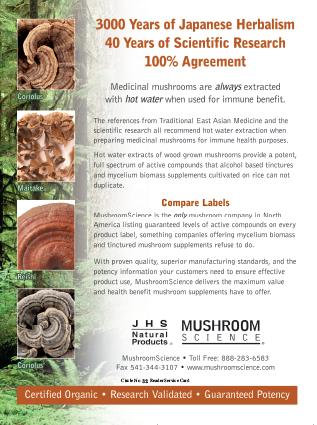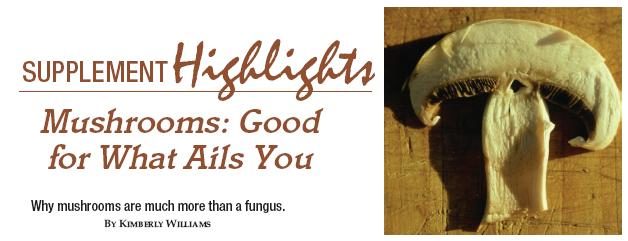Mushrooms are among the most common medicinal remedies. Did you know that of the 14,000 species of mushrooms, only 10% of them have been discovered? There’s still much we don’t know about mushrooms, but the natural products industry has been hard at work to pinpoint why they are beneficial for so many health conditions and offers many supplemental forms of medicinal mushrooms. Their crowd-pleasing likeability is due large-in-part to clinical research, which suggests that their healing potential is abundant. Let’s take a closer look at these medicinal miracles, shall we?
What Makes Mushrooms Tick
Mushrooms are worth their weight in gold; many experts feel their therapeutic effects are attributed in part to their naturally high makeup of germanium, selenium and zinc (1). Research shows that mushrooms contain a number of active compounds: antibiotics, ergosterols, glycoproteins, polysaccharides and triterpenes (2).

• Antibiotics are a form of bacteria that kill microorganisms and bacterial infections.
• Ergosterol, which naturally occurs in yeast, molds and ergot, is a protein.
• Glycoproteins are a group of proteins that consist of a carbohydrate and a nonprotein. The most commonly researched compounds are polysaccharides, which are complex sugar molecules that enhance immune function by increasing the activity of macrophages.
• And, triterpenes are a class of terpenes containing three times as many atoms in the molecule as monoterpenes.
Together, they provide numerous health benefits, which are described in the next section. Space does not permit full descriptions of all benefits of every medicinal mushroom, so check with your supplement makers for complete information about the potential uses of their products.
The “X” Factor
Simply put, Syndrome X is a group of traits that increases one’s chances of getting diabetes, heart disease or stroke. Those who exhibit two or more of the syndome’s symptoms (e.g., high glucose levels, high triglycerides, hypertension and obesity) are diagnosed with Syndrome X. This condition affects close to one in four Americans (3). It develops from the consumption of too many refined sugars and carbohydrates, coupled with a lack of physical activity. However, medicinal mushrooms have been known to benefit those who have some of the tell-tale signs of syndrome X.
Weight Loss. Maitake (Grifola frondosa) may speed up the metabolism process in those who are overweight. A pilot study conducted at the Koseikai Clinic in Tokyo found that those who had heart disease and stroke lost an average of seven to 26 pounds in eight weeks by taking 200 g of Maitake per day with no dietary changes (4). Masanori Yokota, lead researcher, noted that Maitake had such a favorable outcome because it is rich in dietary fiber, one of the staples for maintaining a healthy weight goal.
Diabetes. Mushrooms may also benefit those with high glucose levels, another characteristic of Syndrome X that can develop into type 2-diabetes. Diabetes affects over 16 million Americans and some 250 million people worldwide and “is one of the fastest growing diseases” (2). Research indicates, however, that those with diabetes can greatly benefit from the use of active hexose correlated compound (AHCC). AHCC is a mushroom extract that is obtained by culturing mushrooms in large-scale tanks for lengthened amounts of time. In one Japanese study, for example, diabetics were given three grams of AHCC on a daily basis for six months. Overall, it was determined that blood glucose and glycohemoglobins levels decreased in large proportions in each patient. This is a significant finding because glycohemoglobin is a stable indicator of the average glucose level over any given time period whereas blood glucose levels change readily (5).
Much research also indicates that the use of a specific extract of Maitake mushroom (SX Fraction and D Fraction) may help lower blood glucose levels (3) as well as Cordyceps and Reishi for diabetes support (6).
Heart Disease. Human and animal studies alike have indicated that the cardiovascular system benefits tremendously from Cordyceps (Cordyceps sinesis) (6). This evidence includes studies concerning arrhythmias, chronic heart failure and ischemic heart disease. A randomized, double-blinded, placebo-controlled study examined the results of Cordyceps on high levels of cholesterol. The study, which lasted two months, determined that half of the patients on this treatment had over a 10% decline in cholesterol and more than a 20% decrease in triglyceride levels. A total of 76% of patients had over 10% increases in HDL cholesterol levels.
Make Room for Mushrooms
The list of therapeutic uses for mushrooms also includes immune health, fatigue, neurological conditions and liver health.
Immune Support. Certain mushrooms such as Agaricus blazei Murill, Cordyceps, Maitake and Reishi are said to help increase white blood cell activity, making the immune system better able to take out foreign invaders.
Agaricus is believed to have the highest levels of beta-gulcans (any of several polysaccharides that have glucose units) in the medicinal mushroom category. This mushroom’s immune-enhancement properties have been studied for several applications including HIV/AIDS support (7). Researchers believe Agaricus helps boost immunity by augmenting T-helper cell activity. For example, L.K. Ellertsen, lead researcher from the Norwegian Institute of Public Health, took a close look at the role Agaricus plays in a human monocyte cell line. During this study, changes in mRNA transcripts were measured using microarrays, while changes in select cytokine activity were calculated by immuno assays.
Lipopolysaccharides (LPS) were included in this abstract for comparison purposes. The findings revealed that both AbM and LPS had a drastic impact on gene expression. The study found, “Genes related to immune function were selectively up-regulated, particularly proinflammatoric genes such as the interleukins IL1B and IL8. Although most genes induced by AbM were also induced by LPS, AbM produced a unique profile (8).”
In other research, cordyceps was shown to be a “powerful immune regulator” for helping cells differentiate invaders, exhibit anti-tumor activity and inhibit infection (9). Maitake is said to help enhance NK activity (4) and Reishi may increase the immune system’s response to foreign agents (10).
Chronic Fatigue Syndrome (CFS). Shiitake (Lentinula edodes) has been closely examined for its cholesterol-lowering, anti-bacterial, and anti-viral properties and has been suggested for treatment of CFS. “Chronic fatigue syndrome is a complicated disorder, characterized by extreme fatigue that doesn’t improve with bed rest and may worsen with physical or mental activity” (11). Patients with CFS have low levels of natural killer cell activity along with abnormal T-lymphocyte levels (7). CFS can occur after a viral infection, such as the or cold flu and can begin during or after a stressful period in one’s life.
“Many CFS patients are taking a number of herbal and other natural medications, and some feel much better when they include the mycelial extract of shiitake” (7). The reason why may be because shiitake promotes NK cell action and interferon.
Liver Disease. Reishi (Ganoderma lucidum) may be beneficial to those with poor liver function because of its high levels of polysaccharides that decrease liver enzymes, which skyrocket when the organ becomes inflamed (10). During the early stages of this ailment, individuals may experience inflammation, followed by the development of scar tissue and cirrhosis. Liver failure is the final stage of this life-threatening affliction. Reishi may also help by reducing the production of free radicals in the liver (2).
Neural Function. Using Lion’s Mane (Hericum erinaceus) may inhibit the brain dysfunction associated with Alzheimer’s and other neurological diseases. It is thought to increase cognitive abilities and improve muscle and motor pathways to response (12). Studies have provided evidence that the components found in Lion’s Mane (erinacines and hericenones) stimulate the nerve growth factor (NGF) in neurons. In a Japanese study, 50 dementia patients were given five grams of lion’s mane per day for six months. The results yielded significant changes: the cognitive function improved in most patients.
Mush More than Meets the Eye
We’ve thrown a wealth of information at you about mushrooms. And by now, you know taking these supplements can help maintain good health. But, are you unsure of how much should be consumed? The dosage depends on the type of extract taken, the consumer’s body mass and reasons why the extract is being used. Check labels for a list of the supplement’s mushroom extracts and the levels of active compounds.
Production methods for mushroom supplements range from manufacturer to manufacturer. For example, some experts feel that hot-water extraction and pure extracts offer the most potent, beneficial supplement forms even though the methods may be expensive (6). Mushroom supplements that list the levels of active compounds on the label are usually extracted in this manner (6), but the industry does not have consensus on the best production method. Contact the supplement manufacturer to verify the techniques used. WF
References
1. L.S. Baumann, “Mushrooms: Part II,” Skin & Allergy News, Aug. 2007.
2. L. Vukovic, “Mushroom Magic,” Better Nutrition, Feb. 2007.
3. M. Kaylor and Den Babal, Syndrome and SX-Fraction (Woodland Publishing, Orem, UT, 2003).
4. H. Preuss and S. Konno, Maitake Magic (Freedom Press, Ontario, Canada, 2002).
5. D. Kenner, AHCC: The Japanese Medicinal Mushroom Immune Enhancer (Woodland Publishing, Orem, UT, 2001).
6. M. Stengler, The Health Benefits of Medicinal Mushrooms (Basic Health Publications, Laguna Beach, CA, 2005).
7. B.M. Ley, Medicinal Mushrooms for Immune Enhancement: Agaricus Blazei Murill (BL Publications, Detroit Lakes, MN, 2001).
8. L.K. Ellertson, et al., “Effect of a Medicinal Extract from Agaricus blazei Murill on Gene Expression in a Human Monocyte Cell Line as Examined by Microarrays and Immuno Assays,” Int. Immunopharm. 6 (2) 133–143 (2006).
9. K. Gilbert Udall, Immune and Stamina Booster: Cordyceps Sinensis (Woodland Publishing, Pleasant Grove, UT, 2000).
10. K. Jones, Reishi: Ancient Herb For Modern Times (Healing Arts Press, Rochester, VT, 1995).
11. Mayo Clinic, www.mayoclinic.com/health/chronic-fatigue-syndrome/DS00395, accessed March 9, 2009.
12. H. Kawagishi, et al., “The Anti-Dementia Effect of Lion’s Mane Mushroom and its Clinical Application,” Townsend Letter for Doctors and Patients, April 2004.
Published in WholeFoods Magazine, June 2009









